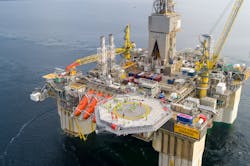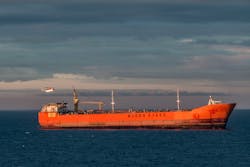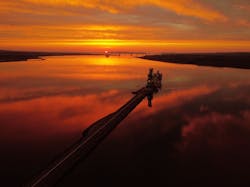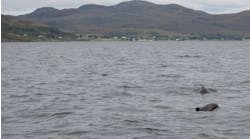Equinor overhauls Njord platform, FSU for 20 years further service
Editor's note: This story first appeared in the July-August 2022 issue of Offshore magazine. Click here to view the full issue.
By Jeremy Beckman, Editor, Europe
TOWARDS THE END OF THIS YEAR, Equinor expects to re-start production from the re-developed Njord field in the Norwegian Sea following a break of more than six years. Bringing a production platform and its associated FSU back to the shore for comprehensive upgrades has been a major undertaking, and a first-time experience for the industry in Norway. The investments should allow Njord and other fields in the area to remain in operation into the 2040s.
Aker Solutions, which re-built the Njord A steel semisubmersible drilling and production platform, had also delivered the original facility in 1997, having constructed and assembled the deck and hull at its yards in Stord and Verdal, western Norway. At the time this was the first EPC contract awarded following the introduction of the NORSOK standard in 1994 to improve the safety and cost-effectiveness of new Norwegian field developments. When Njord started operations in late 1997, 130 km northwest of Kristiansund, its estimated lifespan was around 16 years. But the field produced more oil and gas than expected, and new discoveries emerged nearby, including Hyme, 19 km to the northeast, which was tied into the Njord infrastructure. In 2016, Equinor and its partners decided that a full overhaul of the facilities was needed to ensure a further 20-years of service under the proposed Njord Future development, along with production from Hyme and Njord’s North-West Flank.
Later that year production was shut down with the Njord A platform towed to Stord for refurbishment, and the Njord B FSU to Kristiansund. In mid-2017, Norway’s government approved the plan for development and operation for Njord and Bauge, another discovery in the area that would be tied back to the platform. And in 2018, Neptune Energy and its partners secured approval for a subsea tieback of the Fenja field to Njord A, entailing extra modifications to the platform. Equinor, meanwhile, awarded Aibel the fabrication, installation, construction, engineering and procurement contract for the Njord B upgrades: the engineering group had prior experience in this activity, having recently performed overhauls of BP’s Glen Lyon and Teekay’s Petrojarl 1 FPSOs. Aibel’s workscope would include disassembly and overhaul of equipment, and installation of new systems for reducing emissions to air (VOC facility).
ALTERED SCHEDULE
The original plan had been for Equinor to take delivery of the refurbished Njord A in 2020: however, a combination of the extra scope of work related to Fenja, and the rapid spread of COVID-19, caused the schedule to be pushed back. While work at the main yard in Stord continued through the pandemic, management was obliged to employ some foreign labor for a project of this magnitude. To ensure a strict infection control regime, the company established Norway’s largest quarantine camp outside the gates, with 350 workers on 10-day quarantine for long periods. Aker Solutions performed most of the engineering for the project at its Norwegian offices in Bergen, Fornebu, Stavanger and Trondheim, with the yard in Verdal also handling some of the construction. Around 400 supplier companies were involved, mainly in Norway.
The huge scope of the work, for Norway’s largest renovation project, required erection of 11,000 t of scaffolding in the dock at Stord, and the consumption of 269,000 liters of paint, 11,000 t of sand for sandblasting, and 45,000 t of passive fire protection. Upgrading work on the hull has increased the platform’s buoyancy by 24%, and various new modules have been installed on the topside to receive production from new fields. Other changes include a new helicopter and modern helicopter control system, along with associated safety systems, and electric-powered lifeboats: all underwent testing as part of the seaworthiness trials prior to towing the revised platform back to the field. The lifeboats’ electric motors are said to need less maintenance than diesel engines, and provide improved acceleration when the boats are dropped into the sea, allowing them to get away faster from the platform.
The various modifications and new equipment have increased Njord A’s weight by 11,000 t, said Njord Project Director Tanja Tora Blekastad, transforming it from one of the North Sea area’s smaller platforms to one of the largest. Carl van der Hagen, Project Director at Aker Solutions, added that hardly any part of the platform has not been altered, with the payload capacity on the deck now 31% greater than the original version. Prior to the shutdown in 2016, around half of Njord’s total reserves had been produced and 54 wells drilled. Equinor’s plans at the time included drilling an additional 10 wells, along with the tie-in of the Bauge (ex-Snilehorn) discovery, 15 km east of Njord in 282 m of water, via one subsea template, two oil production wells and one water injector. All three Equinor-operated developments (the other being Hyme) should add 200 MMbbl of production through Njord A over the next two decades.
FENJA TIEBACK
Fenja, the fourth component of the Njord Future project, is an oil and gas field in 320 m water depth, 36 km southwest of Njord A. Previous operator VNG discovered the Pil and Bue reservoirs in 2014, subsequently renamed as the single Fenja accumulation. In April 2018 the Norwegian authorities approved Neptune Energy’s plan for a development focused initially on the 97-MMboe Pil reservoir, with an estimated cost at the time of over $1 billion. The other partners are Vår Energi, Suncor Energy and DNO.
Development has involved drilling six subsea wells in phases – three producers, two water injectors and one gas injector – from two subsea templates and two manifolds; installation of a 37-km subsea pipeline to transport the wellstream to Njord A; two similar-length, 12-in. water and gas injection flowlines; and an umbilical housing six electrical cables, two fiber optic cables and 10 tubes. TechnipFMC supplied and installed the subsea equipment under an iEPCI contract, subcontracting Nymo to fabricate the templates and manifolds. Deep Energy completed most of the offshore subsea construction work in 2019, aside from the export pipeline, which was laid in two phases during 2020-21. Drilling started in 2020, with the Seadrill semisub West Phoenix managing the first phase which included a first dual-drilling operation for the Norwegian sector, with two wellbores drilled simultaneously from one of the templates. The semisub Deepsea Yantai, operated by Odfjell Drilling, was due to complete the third and final drilling campaign this summer.
Fenja’s 37-km electrically trace heated pipe-in-pipe production pipeline, designed and engineered by TechnipFMC in co-operation with Neptune, is the world’s longest for a subsea application to date, and represents TechnipFMC’s second delivery of this technology. The first was for Total Energies’ Islay field in 100 m water depth in the UK northern North Sea, installed in 2011. This was a relatively small system, 6 km long with a 6-in. inner pipe inside a 12-in. outer pipe, a cable rated to 1kV, and was essentially a technology demonstrator, according to TechnipFMC. While active heating was not needed for production, testing allowed the operator to confirm that the insulation was enabling the system to function as intended.
The high wax content in Fenja’s oil and the associated risk of gas hydrates forming at temperatures up to 27°C (81°F), presented a more demanding engineering challenge: following a shutdown, the contents in the pipeline would have to be warmed to a temperature above 28°C (82°F) prior to re-starting flow in order to avoid a potential obstruction.
A trace heating cable is an electrical cable: current passed through the cable warms it up, so when the cable is attached to the pipeline, that in turn warms the pipe, along with its fluids content. With an electrically trace heated pipe-in-pipeline (ETH/PIP), the pipeline is basically a standard PIP system featuring an inner pipe, outer pipe, passive insulation material and centralizers. The ETH/PIP, however, also includes trace heating cables wrapped around the inner pipe in a helical configuration. Each of these cables has three different conductors in a three-phase circuit, and multiple cables can be connected around the pipe for redundancy, ensuring the system continues to function throughout the pipeline’s designed life. Cables are attached next to the inner pipe, beneath the passive insulation: as they warm up when energized, the insulation ensures that all the heat is transferred to the inner pipe and its fluids.
There is also the option to install optical fibers, again wrapped helically around the inner pipe under the insulation material. The fibers can be used to measure the temperature in the inner pipe: those measurements, combined with the active heating, allow the operator to control the system and have confidence that the temperature will not dip to a range where there is a risk of wax/hydrates forming. The system is connected to a power supply, typically on the host platform topsides, which controls the monitoring unit. From the topsides umbilical termination assembly, power is sent down the umbilical to a subsea umbilical termination on the seafloor which is connected to the PIP via flying leads. The leads in turn provide connections to various penetrators that provide the electrical continuity into the PIP’s dry annulus. The cables run inside the PIP to its far end, where the 3-phase cables are connected to each other using a star point system.
Fenja’s 37-km PIP comprises a 12-in. inner pipe inside an 18-in. outer pipe, with the electrical cables rated to a 3.8-kV (medium-phase) voltage. Omnisens engineered and supplied a distributed temperature sensing system that will be used to monitor the pipeline for potential leaks. According to a spokesperson for Neptune Energy, engineering of the ETHPIP, seen as critical to production from the field, involved years of qualifying the technology, covering everything from the cables to the connections. “This program was not related specifically to Fenja’s wellstream, but rather the distance and capacity required for this project. Another challenge, compared with the Islay ETHPIP, was extending the technology from a low-voltage to a high-voltage regime. Each component of the ETH system has been tested alone and as a system before and after installation. The final test will be performed when the host platform is connected and ready, most likely during the current quarter.”






